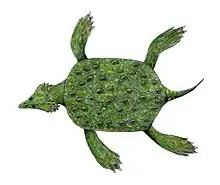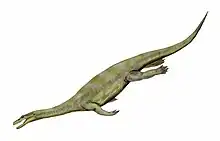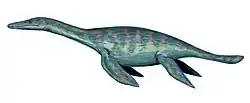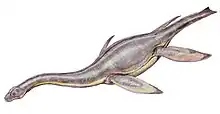| Sthenarosaurus Temporal range: Early Jurassic, | |
|---|---|
 | |
| Pectoral girdle of Sthenarosaurus .sp.[1] | |
| Scientific classification | |
| Kingdom: | |
| Phylum: | |
| Class: | |
| Order: | |
| Superfamily: | |
| Family: | |
| Genus: | †Sthenarosaurus Watson, 1909 |
| Binomial name | |
| †Sthenarosaurus dawkinsi Watson, 1909 | |
Sthenarosaurus (meaning "strong lizard") is an extinct genus of rhomaleosaurid pliosauroid discovered in the Toarcian-aged 'Main Alum Shale' (Commune subzone of Bifrons zone)[2] in Whitby, England.[3] The type species, S. dawkinsi, was named and described in 1909.[4] The type specimen is MMUM LL 8023, a set of postcrania discovered in Whitby. Other indeterminate specimens are known,[3] including a pectoral girdle (pictured in taxobox) described in 1911.[1]
Description
The holotype is known from an incomplete skeleton with no skull. A precise reconstruction is not possible, but it is assumed that Sthenarosaurus was a small plesiosaur, reaching up to 3 metres (9.8 ft) long when fully grown.[5] The coracoids were short and thick, while the pelvis was broad and strong. The dorsal vertebrae possessed short, but very broad and high vertebral centers, with thick neural spines. Eighteen cervical vertebrae are preserved, and vary greatly in size: the largest is almost double the smallest; this suggests that if the entire neck had been made up of even a few more vertebrae than those preserved, the animal would have had a strange appearance, due to noticeable thinning of the neck in the head area.[6]
Classification
Sthenarosaurus has been placed in the Pliosauroidea within Plesiosauria since it was described in 1909.[4] It was the sister taxon to Archaeonectrus (known at the time as "Plesiosaurus" rostratus), based on similarities in the shape of the shoulder blades, coracoids and cervical vertebrae.[4][1] Compared to Archaeonectrus however, the cervicals of Sthenarosaurus were longer. It is possible that Sthenarosaurus represents a currently unknown clade of plesiosaurs.[3]
See also
References
- 1 2 3 Watson, DMS, 1911, A plesiosaurian pectoral girdle from the Lower Lias: Memoirs of the Manchester Literary and Philosophical Society, v. 55, n. 6, p. 1-7.
- ↑ Sepkoski, Jack Sepkoski's Online Genus Database – Cephalopoda
- 1 2 3 Smith, A. S. (2008). "Plesiosaurs from the Pliensbachian (Lower Jurassic) of Bornholm, Denmark" (PDF). Journal of Vertebrate Paleontology. 28 (4): 1213–1217. doi:10.1671/0272-4634-28.4.1213. S2CID 128999502.
- 1 2 3 D. M. S. Watson. 1909. IV. A preliminary note on two new genera of upper Liassic plesiosaurs. Memoirs and Proceedings of the Manchester Literary and Philosophical Society 54(4):1-28
- ↑ D. S Brown. 1981. The English Upper Jurassic Plesiosauroidea (Reptilia) and a review of the phylogeny and classification of the Plesiosauria. Bulletin of the British Museum (Natural History) 35 (4): 253-347
- ↑ T. E White. 1940. Holotype of Plesiosaurus longirostris (Blake) and classification of the plesiosaurs. Journal of Paleontology 14 (5): 451-467






.png.webp)